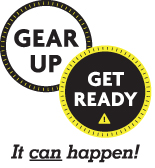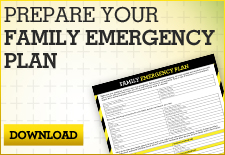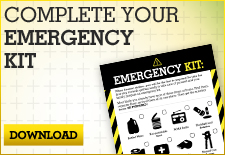
What Will You Need?
In extreme situations resources may not be immediately available to you. Take action today and develop an emergency kit. Your emergency kit contains basic items you and your family may need if an emergency happens. Most of these items can be found around your home, and should be collected into one place before a disaster happens in case you need to evacuate at a moment’s notice. If you do not have these items, consider low‐cost sources in your community to purchase them ‐ such as your discount grocery store or retailer. Also, consider making additional purchases over time to increase your preparedness while making the kit affordable. Click here to download the Emergency Kit list.
Remember to check your kit on a regular basis. Some items in the kit can expire ‐ like canned food and bottled water. If you check your kit regularly, you can swap out these items with fresh supplies and use the canned goods for regular purposes, like including them in lunch or dinner.












Calculate the amount of items your family will need with the Emergency Preparedness Supplies Calculator.
Vehicle Emergency Kit
Roadside emergencies can happen at any time and under any circumstances. Keep a kit of emergency supplies in your car in case you are stranded, or that you need to evacuate at a moment’s notice.
- Food
- Water
- First aid supplies
- Flares
- Jumper cables
- Cell phone and charger
- Fire extinguisher
- Warning light, hazard triangle or flares
- Extra clothing, especially a blanket, hat and jacket in the winter
- Auto-club card or roadside-assistance number (if you belong to an auto club or roadside-assistance program)
- $20 in small bills and change
- Pen and pad of paper
- Jack and lug wrench, in case of a flat tire
- Weather-proof flashlight
- Gloves, hand cleaner and clean rags
- Tire gauge
- Help sign
- Windshield scraper
- Bag of cat litter (even if you don’t have a cat!)
Cat litter can provide traction on slick surfaces, specifically roads that are icy in the winter - Tools and supplies, such as fuses, wrenches, screwdrivers, wire cutters, a knife, and hose and repair kits can be helpful during an emergency, specifically if your car breaks down
A Go Kit should be easily accessible if you have to leave your home in a hurry, and each household member’s Go Kit should be packed in a sturdy, easy-to-carry container such as a backpack. Make sure it is ready to go at all times of the year and contains items suitable for the season.
- Food & Water
– Bottled water and non-perishable, ready-to-eat and lightweight foods such as energy or granola bars - Flashlight
– Hand crank model preferred or have extra batteries - Radio
– Hand crank model preferred or have extra batteries - Manual can opener if you have canned goods in your kit
- Phone
– Wireless phone, fully charged - Documents
– Copies of important documents (insurance cards, photo IDs, proof of address) in waterproof, portable container like a zip lock bag
– Emergency Card: Complete your emergency contacts card right now!
– List of local, out-of-state, family and emergency contact information - Personal hygiene items
– Soap, feminine products, toothbrush, toothpaste, toilet paper, etc. - Whistle
- First Aid Kit
- Cash
- An extra set of keys for your home and your car
- Matches in a water proof container
- Compact mess kits for eating and preparing meals
- Paper, pencil and tape
- Tarp, tent, or poncho for rain or inclement weather
- A recent family photo for identification
Remember to account for your family’s special needs. This might include child care items for infants, family medications, and pet supplies. Keep a list of all medications taken by your household, dosages, and information regarding your physicians in your Go Kit.
For additional information on what you might need or what you might do if a disaster happens in your community, visit the following websites:











